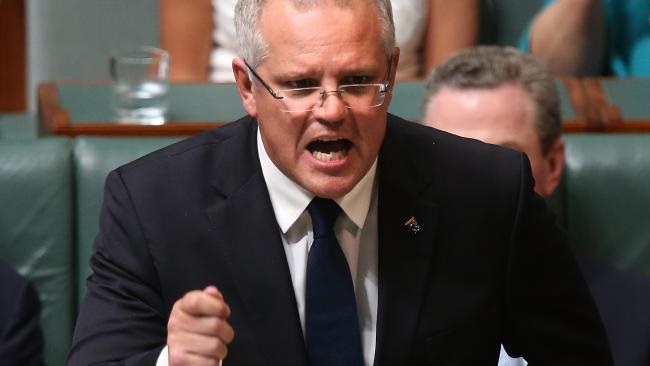11 February 2017
Simon Benson
The Australian
Australia faces a potential investment crunch with Treasury analysis revealing that foreign direct investment has already crashed almost 50 per cent on 2015 levels.
The downward trend is more concerning because it runs against growing global flows; Australia’s share of the $US1.8 trillion ($2.36 trillion) global foreign direct investment pool tumbled from 3.2 per cent in 2011 to 1.3 per cent last year as other countries became relatively more attractive.
Seeking to intensify the urgency of the debate over the government’s corporate tax plan to cut rates to 25 per cent, Scott Morrison told The Weekend Australian the analysis showed that Australia was already on a worrying slide down the world investment rankings, partly because of its high company tax.
A senior government source said that while Australia had weathered the worst of the fall since the end of the mining investment boom, the concern was that it was failing to pick up its share of the investment recovery since the end of the global financial crisis. Of equal concern was that conditions could further deteriorate, with the US, our largest source of investment, headed for a company tax rate of 15 per cent — half Australia’s — which could cause a flight of capital back to the US.
According to the Treasury analysis, foreign direct investment had begun falling even during the mining construction boom — by an estimated 15 per cent from 2006 to 2015 — but the downward trajectory had since steepened despite global direct investment flows increasing 25 per cent since the end of the GFC and 38 per cent year-on-year in 2015.
“Between 2011 and 2015 Australia was the 10th largest destination for investment, but has fallen to 18th in 2015,” the Treasurer said.
Mr Morrison made a direct link between the falling level of foreign direct investment and Australia’s company tax rate, which had failed to keep pace with the lower tax environments being pursued by other OECD countries.
He seized on a speech by Reserve Bank governor Phillip Lowe on Thursday in which he implicitly rejected Labor’s claim that the budget could not afford corporate tax cuts. Mr Lowe argued Australia needed to respond to lowering tax rates among competitor nations.
“The independent RBA has made it clear that Australia must have a competitive business tax rate,” Mr Morrison said.
“We need to be internationally competitive to attract investment, to encourage business to set up or expand their operations in Australia, to hire more and to buy more machines and equipment that boost our economy.
“Fifteen years ago we had the ninth lowest business tax rate among advanced economies. Today just five of the 35 OECD nations have a business tax rate higher than Australia’s.
“With the largest source of investment coming from the US, our tax rates must remain competitive because our attractiveness as a place to invest may be impacted by a reduction in the US corporate tax rate that might reduce outward investment from the US and divert investment away from Australia to the US.”
Mr Morrison said that while indirect foreign investment remained healthy, direct investment, such as foreign companies setting up Australian operations or expanding existing ones, was in a worryingly decline.
“The RBA governor makes it clear that our tax system is becoming uncompetitive and that we risk becoming stranded internationally and constrained in our efforts to increase investment in jobs and wages.
“Governor Lowe has sounded an independent warning that Australia is falling further behind our international competitors in being able to attract the critical investment we need to grow Australian jobs and lift wages.”
In 2015, global foreign direct investment flows jumped 38 per cent to an estimated US$1.8 trillion, their highest level since the GFC, but in Australia the same year the flow fell 44 per cent.
Even during Australia’s mining construction boom the flow of foreign direct investment fell 15.4 per cent from $US26.3 billion in 2006 to $US22.3bn in 2015. Mr Morrison cited the International Monetary Fund’s recent claim that foreign investment increased 4.4 per cent for every percentage point cut in the business tax rate.
It suggested a 10 per cent increase in foreign direct investment over the period 2010 to 2020 would increase real GDP by 1.2 per cent.
In his speech to the A50 Australian Economic Forum, his first for the year, Mr Lowe said Australia was built on the free flow of capital. “For more than two centuries now, capital from the rest of the world has helped build our country,’’ he said. “If we had had to rely on just our own resources, we would not be enjoying the prosperity that we do today.”
Labor infrastructure spokesman Anthony Albanese yesterday dismissed Mr Lowe’s assessment that company tax cuts were needed, instead citing the Reserve Bank chief’s calls for more infrastructure investment.
“Given the need to fund education and healthcare, given the need to provide support for the economy, what the government shouldn’t be doing is pursuing the $50bn of cuts, most of which, as a result of the structure of their proposal, will go to the very large corporations,” Mr Albanese said.
“Philip Lowe has repeated the comments that he has made, and that were made by his predecessor Glenn Stevens, that what Australia needs is a significant increase in infrastructure investment. He correctly has identified the fact that borrowing can be made and funds made available at a very cheap rate at the moment because of the record low interest rate environment.”

